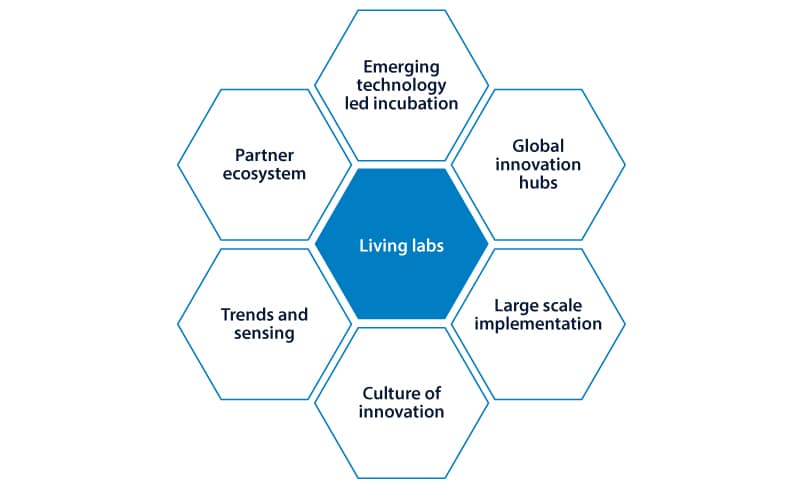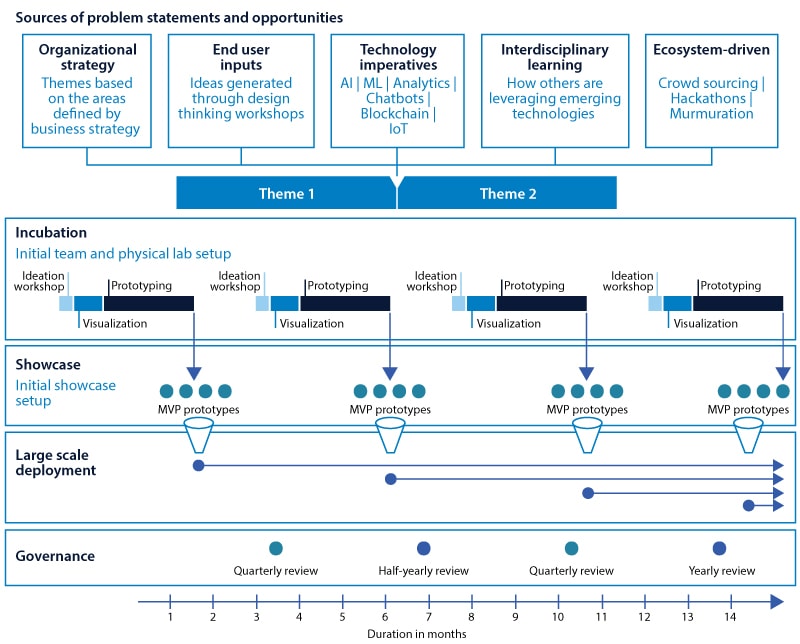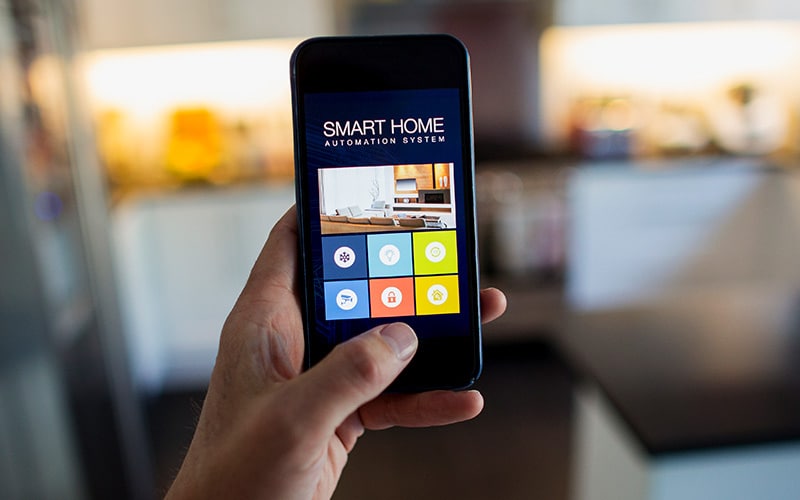Incumbent corporations are confronted with a harsh reality. They cannot innovate at the same pace as their disruptive counterparts. Digital disruptors outpace incumbent organizations when it comes to innovation. This is attributed to incumbents’ typical innovation strategy.
In the 2018 CB Insights “State of Innovation” report, 60 percent of companies stated creation of new products takes a year or longer and 78 percent of innovation portfolios are dedicated to incremental innovation focused on maintaining status quo1.
Disruptors, by comparison, do not have a status quo. Instead they invest in innovation efforts that challenge the status quo, not maintain it. What makes innovation difficult for incumbent companies is their commitment to maintain what works now and their lack of platforms and processes supporting rapid innovation.
Incumbent companies are here today because they have long histories of success. They found a successful business model and exploited it. Companies should sustain what has made them successful, but being blinded by their current success is dangerous.
Eastman Kodak was successful with a film business model that monetized the creation of memories. The “Kodak moment” became synonymous with events people wanted to capture and cherish. Executives should be particularly concerned with a different Kodak moment - one that serves as a lesson in what happens when you fail to innovate.
“You press one button and we do the rest,” said George Eastman, founder of Eastman Kodak. Any person who could operate a camera was capturing important moments in their lives. Yet cameras were not Kodak’s moneymaker. It was Kodak’s film and printing business model that made the company billions of dollars.
In 1975 Steve Sasson, an engineer at Kodak, invented the first digital camera. Kodak invented the first domino that would start the disruption of its own business model. For the next three decades Kodak continued to release film and printing products. They began to sell printers and the Easyshare digital camera (but you still had to print the photos). Kodak even purchased Ofoto, a photo sharing website, but repurposed it for photo printing. Kodak declared bankruptcy in 2012.
Digital cameras replaced roll film cameras, and companies like Instagram became the new norm for photo sharing. Kodak did not realize their business model, which made them so successful, was going extinct. Kodak saw digital photography as a means to improve their printing business. They failed to realize that sharing photos online was the new business.
Incumbents need to recognize that failing to innovate means you will be disrupted.
With the rise of digital natives, this disruption is occurring far faster than the thirty years it took for Kodak to be disrupted. BlackBerry’s business model, for instance, was disrupted in roughly ten years. How will incumbents innovate rapidly and avoid disruption? The conversation leans toward buzzwords like being agile, changing your culture, hiring creatives, and failing fast. The problem is, these are tools to enable effective innovation. They are not solutions to innovation. Solutions being the combination of methodology, processes, and practices that are clearly defined and actionable.
Innovation labs serve as an example of using the right tools but not clearly defining the innovation processes and practices to support them. While initially viewed as the solution to incumbent enterprises’ innovation struggle, innovation labs have proven to be another trendy tool.
Innovation labs are not the solution
Five years ago, large companies began to invest in innovation labs - spaces for innovation to flourish. These labs employ creatives like illustrators and industrial designers and are housed separately from the core business. Innovation labs intentionally avoid traditional professional corporate culture and layout. The spaces have whiteboards, sticky notes, and ping pong tables, and the people chatter about new gadgets and technology.
While rapid innovation was the original goal, innovation theater has too often been the output - more about the appearance of innovation, and not the substance. These labs generate concepts but fail to achieve tangible outputs for businesses they support. This has led companies like Coca-Cola, Ogilvy, and Disney to shutter their labs. These closings are happening because innovation labs are becoming more trendy overhead than reliable engines that create value.
In order to innovate rapidly and compete with disruptors, incumbent corporations require an innovation solution that is available the moment it is needed and gone when it is not. They need a solution that pops up to supply platforms and processes necessary to innovate - a solution similar to that of pop-up shops.
Pop-up retail
Pop-up shops, or more precisely pop up retail, were created to fill a gap that retailers were missing. How can you connect with customers in a declining retail market and an oversaturated online market? Pop-up shops were the answer. Reasons to launch a pop up include testing a market for new products or future store locations, to drive sales, or to better understand current customers. Temporary pop-up retail delivers value that permanent spaces cannot provide. Kevin Gill, Head of Retail at Start Design, comments:
This is also in stark contrast to the time consuming design and development process required for a permanent store. Because of their style, pop-ups are a fast way to respond to changing customer needs and shopper [behavior]. The process empowers brands to get ideas to market quickly, test these with shoppers and then incorporate any responses or feedback into future plans, something that many traditional retailers are yet to [internalize2].
Much like retail, incumbent companies need to be able to respond to changing market pressures relating to emerging technologies and socioeconomic changes that will impact their business.
Pop-up innovation

Living labs are pop-up innovation. Living labs run from a few days to a year depending on company needs. As a pop-up shop is designed to support a particular market, living labs are designed to support the specific contexts a company faces. They are an end-to-end model that goes beyond whiteboards and sticky notes to deliver vetted solutions that are implemented in real world contexts.
End to end
Living labs are a joint endeavor that involves a leader, real users, and a network of partners. The process makes living labs special. Through living labs’ process, “We are capable of moving quickly on feasibility and results - not just concept,” commented Ben Ingram, Innovation Lead at Brilliant Basics. The process involves point of view and problem framing, ideation, visualization, rapid prototyping, and continuous user involvement, which create the formula for rapid innovation. Through the living labs model, incumbents take a solution from concept to large-scale deployment in a quarter of the time as opposed to the year or longer that incumbents typically experience.
Point of view and problem framing
The first step is to identify the problem facing your business and develop a point of view. Living labs take a problem-centric approach to innovation as opposed to a solution centric approach. For example, throughout framing, clients and partners will develop a point of view on the current and future challenges that will impact their business. These challenges cover emerging technologies, disrupted business models, and socioeconomic changes that will impact companies.
Ben Ingram explains, from his experience, that traditionally people do not go past concepts and trends. “This isn’t just going to [the client] and saying we think some sort of mixed reality will be popular in the future.” Problem framing goes one step further. “It is saying, mixed reality will have a huge impact on your ability to train your staff and monitor offshore equipment.” Problem framing involves defining challenges, gathering research relating to the impact and underlying technology, and empathizing with relevant human needs. Only when a strong point of view of the problem is framed should you move toward ideation of solutions.
Ideation and visualization
Clients work with partner domain experts and users to create a pool of ideas, over one to three days, that will be framed for further investigation. The concept is to brainstorm ideas and create assumptions and hypotheses to test through visualization. Typically, sixteen to twenty ideas are generated and four or five are selected to be developed into proofs of concept. Through visualization, wireframes are created to show basic functionality, user experience, and design directions. Visualization allows product owners to have a depiction of a solution that is testable against assumptions and hypotheses.
Rapid prototyping
Over a period of eight to ten weeks, clients build prototypes that are capable of interacting with back-end systems and demonstrate how a desired solution will function. Rapid prototyping involves executing single proposition experiments to provide a testable outcome compared to assumptions, and then iterating until the desired outcome is realized. Rapid prototyping is the vehicle that validates a solution against technology feasibility and the business processes in place.
Typical progress of living labs

User showcase and evaluation
User involvement is needed to deliver whole solutions and living labs position users throughout the endeavor. Users challenge and test whether a product wholly solves identified problems. Users identify where solutions are lacking. Showcasing solution prototypes to users identifies features, functionality, or design that was overlooked when assumptions were made. In living labs, users are involved in each step.
High level user involvement creates a cycle of constant challenge and iteration to increase chances of companies realizing truly innovative solutions - that is, solutions which meet objectives of desirability (functional and emotional), feasibility (organizational and technological), and viability (economic) when launched.
Living labs outcomes
Living labs are being used by incumbent organizations to tackle the real issues they are facing, both tactical and strategic. The automotive industry is faced with vehicles becoming more advanced in technology and information systems. The problem: how to keep driving safe without sacrificing the benefits of onboard technologies and information systems. To answer this question, Toyota’s Driver Awareness Research Vehicle 1.5 (DARV 1.5) was created.
Through living labs, Toyota, with partner guidance, created a research vehicle that utilizes Microsoft technology (Kinect motion tracking and surface tablets) and custom biometric software to ensure everyone in the car works in tandem with the vehicle for safer driving. For example, a driver wants to make a change in their navigation system while driving. Through biometrics developed by the partner, the vehicle recognizes that the user is driving and prevents them from performing this action while the car is moving. Conversely, using the same biometrics, the vehicle identifies a passenger who is trying to perform the same action and allows it.
“These technologies will help save lives, improve the environment, create jobs and help us maintain technical leadership in a field that is an important contributor to economic growth,” said Osamu Nagata, President and CEO of Toyota Motor Engineering and Manufacturing North America3.
Other examples of client outcomes achieved through living labs include aiding a large agricultural tech company in farm field mapping through smart devices, location-based customer engagement for a UK-based beverage maker, and improving young driver safety through gamification and location-based services for a large North American insurance company.
Action over deliberation
The biggest barrier incumbents have to overcome is their commitment to what makes them successful right now. Both Kodak and BlackBerry failed to see past their current success and look at what would impact their business models in the future. They did not have points of view on how their business would be impacted by emerging technologies like digital cameras and touchscreen phones.
Incumbent companies need to invest in innovation efforts that support their business objectives and solutions that support their future. The days of sitting back and watching how the market plays out are over. This sort of complacency is the killer of incumbents. At one point, BlackBerry was the top smartphone in the world. When the iPhone was introduced, BlackBerry’s CEO Jim Balsillie said, “It’s OK - we’ll be fine.” In less than ten years, BlackBerry went from controlling 50 percent of the smartphone market to nothing.
The need of the hour
Incumbent companies need to explore and invest in innovation that allows them to innovate now, because disruptors are, well, disrupting. Innovation is not something that just happens.
A platform of processes, exercises, and resources is imperative to make innovation a reality.
Through the living labs model, incumbent organizations will develop the capability – that mental muscle to create and deploy innovative solutions in a matter of months as opposed to years. As Ingram states, “We are going on a journey with the client, taking solutions from conversation to something physical and tangible.”





